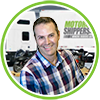Harley Drops Again, But There is Good News

Posted By

Clint Lawrence, founder of Motorcycle Shippers. Helping give riders more freedom to enjoy the bikes they love. [email protected]
Can Harley Stop Its Sales Skid?
The numbers are in, and they won’t come as a shock to anyone who follows the motorcycle industry: Harley-Davidson just posted yet another quarter of falling sales. The drop was sharper than expected in the U.S. market, fanning the flame for skeptics who say the brand’s days as a major motorcycle manufacturer are numbered.
What does this latest financial report mean for the most iconic motorcycle brand in America? Here’s the bad news, the good news and the “Hail Mary” that could help accelerate Harley’s sputtering sales.
The bad news
Riders already know that the U.S. motorcycle industry has been suffering since the recession. Motorcycle sales peaked at more than 1.1 million in 2005. But new sales have plummeted by 50% since 2008, with fewer bikes owned in every age bracket under 40. With more Baby Boomers retiring their motorcycles, there aren’t enough Millennial riders to offset the gap.
In a recent study, Millennials said they do consider purchasing motorcycles—for “ease of transportation.” This is a much different reason than cited by the older rider demographic, which chooses to own bikes as a “hobby” or because “motorcycles are cool.” (In case you’re wondering, the average Harley rider is now 50 years old with a household income of $90K.) With practicality becoming an increasingly important purchasing decision, Harley has some work to do. Otherwise, as one market researcher predicts, it could become the latest brand “killed” by Millennials.
Declining sales. Millennial disinterest. Tariffs galore. What does that mean for the U.S. motorcycle market? More than a decade since the recession, the industry is still struggling to recover—and Harley has been far from immune to the turbulence.
In Harley’s just-released earnings report, its U.S. sales dropped 8% in the second quarter, which is significantly more steep than the expected 6% decrease. This marks the company’s 10th consecutive quarter of declining sales. But more concerning is its international motorcycle sales, which have dropped 8.9% since this time last year. In Europe, which makes up 47% of Harley’s international sales, motorcycle purchases have decreased 14%. Even China’s interest in motorcycles isn’t enough to offset that unexpected downturn.
And that’s just the half of it.
Once lauded by the president as an “American Icon,” Harley has also found itself caught in the political quagmire. After the federal tax cut last year, the brand spent $700 million on stock buybacks and closed its Kansas City plant—wiping out 260 jobs and angering both sides of the political aisle. With the Trump trade war heating up, Harley shifted some production overseas and began the process of opening up a plant in Thailand. Depending on who you ask, Harley’s (mis)use of the tax cut and its turn away from U.S. manufacturing have left a sour taste in the public’s mouth.
The good news
Harley’s Made in the U.S. motorcycles face a stiff 31% tariff when entering the European Union. However, the EU recently provided a silver lining to the brand’s woes: Harleys coming from Thailand will only face a 6% tariff. The brand is betting that Europeans will recognize that its operations in Thailand are simply a result of the tariffs and not cutting corners on quality.
But even this positive comes with a dose of reality. Because the EU delayed its decision, Harley had to push back its shipment of bikes from Thailand to Europe until mid-2020. It shifted down its shipment forecast accordingly, putting the number of Harleys shipped globally in 2019 at about the same level as 2010—the thick of the recession.
Are EVs the “Hail Mary?”
Harley is betting big on technology to accelerate its sales. The brand opened up a Silicon Valley office last year to support its vision for a full line of electric motorcycles and scooters. This comes hot on the heels of its much-anticipated LiveWire launch, which is slated for next month.
The battery-powered LiveWire, which generated major buzz at the Consumer Electronics Show earlier this year, can go from zero to 60mph in three seconds, topping out at 110mph. Its charge time is one-hour flat for a city range of 146 miles; that’s 95 miles for a combination of city/highway riding. To sweeten the deal for consumers, Harley has partnered with Electrify America to give LiveWire riders 500kWh of free charging time over two years—the equivalent of about 32 fill-ups. Riders will be able to locate these charging stations, roughly 70 miles apart, using a new Harley-Davidson app.
Will electric motorcycles be Harley’s saving grace? Could a new line of EVs satisfy Millennial hunger for a more practical ride? It’s too soon to tell. But one thing is undeniable: the mix of tariffs, declining Millennial interest and politics has already dealt a heavy blow to a motorcycle brand once seen as invincible.